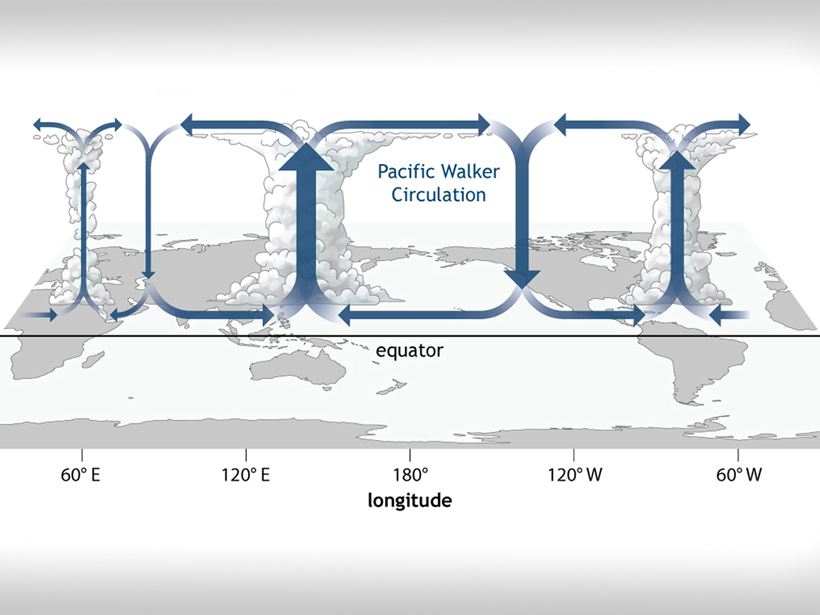Source: Geophysical Research Letters
The Walker circulation is an east–west or west–east trending air circulation pattern located over the tropics and forms one of two major convective patterns in Earth’s tropical atmosphere. Specifically over the tropical Pacific, air just above the surface flows from east to west; as warm air rises over the western Pacific, it produces rain clouds, which wring the air of moisture. This lofted cool air travels east across the Pacific until it sinks, pushing air on the surface back to the west and completing the cycle, forming a convection cell.
This air circulation drives global weather patterns and is tied to monsoons—as well as to the El Niño effect, in which this circulation grinds to a halt and then reverses. This disrupts weather patterns around the world, causing tens of billions of dollars in economic damage.
Scientists typically model the Walker circulation in the atmosphere including the effect of damping—in which the winds lose energy due to friction and radiative cooling. This is a standard feature throughout climate models of the tropics.
Now Stechmann and Ogrosky have overturned this conventional wisdom, discovering that damping does not play a major part in the Walker circulation and does not need to be included in simulations. Instead, they revamped the model for the Walker circulation: The currents of air simply depend on the natural response to the atmosphere being heated by clouds.
The authors analyzed data collected by the National Oceanic and Atmospheric Administration and National Centers for Environmental Prediction/National Center for Atmospheric Research to reconstruct the large-scale atmospheric wave patterns that accompany Walker circulation and reflect its strength. They then used a simple model to simulate the atmospheric wave patterns that account for heat and momentum losses, including any damping. They found that damping wasn’t necessary to model the Walker circulation and that variations in the amount of cloud heating in the atmosphere are responsible for its behavior.
The team also discovered that these variations in cloud heating are proportional to the amount of energy that radiates from Earth into space, called the outgoing longwave radiation (OLR). This allowed the team to use satellite observations of OLR to estimate atmospheric heating. This means that future studies could use such satellite data—including archived data—to easily estimate the strength of the Walker circulation over time. (Geophysical Research Letters, doi:10.1002/2014GL062257, 2014)
—Catherine Minnehan, Freelance Writer
Citation: Minnehan, C. (2015), Rethinking how tropical convection works, Eos, 96, doi:10.1029/2015EO032677. Published on 17 July 2015.
Text © 2015. The authors. CC BY-NC 3.0
Except where otherwise noted, images are subject to copyright. Any reuse without express permission from the copyright owner is prohibited.

